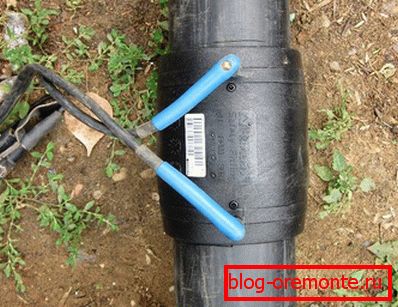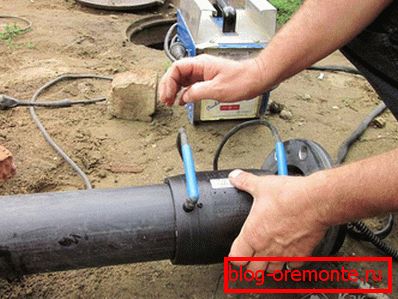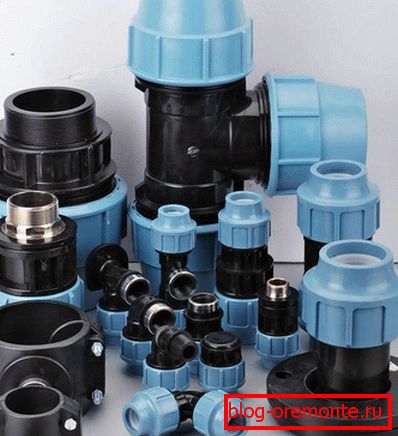Diy installation of hdpe pipes
If you are building a house or doing repairs in an old dwelling, then you are probably faced with the need to replace rusted steel pipelines with new ones. Best of all, plastic or plastic low-pressure products (HDPE) are suitable as an alternative to metal. Installation of HDPE pipes with their own hands is very simple, even without special knowledge. As a rule, manufacturers apply assembly instructions to their products.
In addition to ease of installation, pipes from HDPE have other advantages that explain their ever-increasing popularity:
- they are resistant to most chemical compounds;
- polyethylene does not corrode;
- when freezing inside the water, they do not crack;
- well tolerate water hammer;
- do not rot and are not affected by fungi and bacteria;
- elastic and therefore suitable for use in seismically hazardous regions;
- transportation and installation of plastic is cheaper by 2-3 times than transportation and installation of metal products;
- service life exceeds 50 years.

The lack of PND pipes is that they can serve at temperatures up to 40 ° C, i.e. not suitable for hot water.
There are two types of pipes:
- Free-flow - for sewage and storm drains;
- Pressure - for gas pipelines and water systems.

The wall thickness of the HDPE pipes varies from 2 to 72 mm, and their diameter is from 20 to 1200 mm. The sizes are selected depending on the place of installation and destination. To supply water to the house most often used products with a cross section of 20 to 30 mm using compression brass or plastic fittings. At arrangement of the sewerage choose pipes PND with a diameter from 90 to 160 mm, fastening them with couplings with sealing rings.
For pipes of different sizes, there are 3 different methods of connection:
- Butt welding - one-piece type, is performed using a special apparatus;
- Electrofusion welding;
- With the use of fittings and flanges - split type of installation.
All-in-one connections are more suitable for high pressure pipelines. The seam obtained as a result of welding, goes even stronger than the body itself.
Butt Welding Technology

Welding increase pipes with a cross section of more than 50 mm and with a wall thickness of more than 5 mm. This is a rather complicated method that requires some operator training and the presence of a welding machine. The procedure is as follows:
- The edges of the pipes are aligned, cut at a right angle and carefully cleaned.
- They are then heated to melting point and quickly combined.
- Wait for the seam to cool.
During the work it is necessary to monitor the time of heating and pressure on the joined surfaces. The weld should be uniform along the entire length, then it will be as durable as possible.
No need to try to weld two pipes from different manufacturers. Characteristics of polyethylenes can vary considerably, and the resulting seam will break off from the pressure of the water.
Electrofusion welding

This method of fastening consists in the use of shaped elements with built-in electric spirals. Spirals heated and melted polyethylene, tightly soldering the pipe.
This method is used when mounting sections with a cross section of less than 160 mm, or when access to the docking place is difficult. The diameters of the welded pipes should not differ by more than 10%.
To make the connection, the edges must be cleaned of dirt and leveled. And also fix for the time of work. This will help the positioner.
Both ends are inserted into the sleeve and the welding machine is switched on. The duration and temperature of heating is usually indicated on the barcode of the part.
Pipe fitting fittings

For pipes of small size, cross-section up to 110 mm, removable connections are more suitable. Of them mounted plumbing and sewage in city apartments.
For assembly, you will need brass or plastic compression type fittings and socket plugs with flexible seals.
In the same way as in welding, we cut the pipes to the desired length, and the ends are performed strictly perpendicular to the body.
We unscrew the cap nut of the fitting a few turns and insert the tube into it to the end. It should fit into the rubber seal with force. After that, you need to put on the collet and elastic ring and tighten the nut. Small parts are screwed by hand, but for mounting pipes of larger diameter it is better to use a wrench. At the end do not forget to check the tightness of the connection.
Pipe holders

The pipeline from PND fastens to walls clamps. Moreover, for reliability, they are installed under each joint. In the remaining sections, the distance between the fasteners is 10 pipe diameters. The distance from the walls is 2–4 mm.
Usually use hard noise absorbing clamps with rubber seals. But in order to prevent internal stresses in the pipes during operation, some holders are installed without a gasket, leaving the pipeline to lie in the mounting ring freely. This will allow him to maintain mobility and serve for many years without much care.
Video
In the following video you can see how to fasten HDPE pipes with fittings: